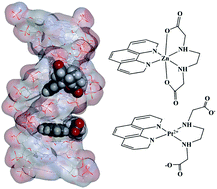The DNA binding site specificity and antiproliferative property of ternary Pt(ii) and Zn(ii) complexes of phenanthroline and N,N′-ethylenediaminediacetic acid†
Abstract
The binding site specificity of the ternary complexes, [M(II)(phen)(edda)] (M(II) = Pt2+ and Zn2+; phen = 1,10-phenanthroline; edda = N,N′-ethylenediaminediacetic acid), for the self-complementary oligonucleotides (ODNs), ds(C1G2C3G4A5A6T7T8C9G10C11G12)2 (ODN1) and ds(C1G2C3G4T5A6T7A8C9G10C11G12)2 (ODN2), was studied by NMR measurements. The results indicated that [Pt(II)(phen)(edda)] was partially intercalated between C3/G10 and G4/C9 base pairs of ODN1 and ODN2 in the major grooves, whereas [Zn(II)(phen)(edda)] was bound specifically to the TATA region of ODN2 in the minor groove and to the terminal G2/C11 base pair of ODN1 in the major groove. The preference for the TATA sequence over the AATT sequence in the binding of [Zn(phen)(edda)] was attributed to the wider minor groove width of the TATA sequence. The bindings of the complexes to ct-DNA were also studied by UV, CD, and fluorescence spectroscopy. Additionally, the antiproliferative property of [Pt(II)(phen)(edda)] towards MCF7 breast cancer cells and normal MCF10-A cells was compared with that of [Zn(II)(phen)(edda)].


 Please wait while we load your content...
Please wait while we load your content...